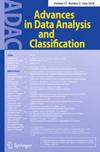矩阵正态分布的对偶子空间简约混合
IF 1.3
4区 计算机科学
Q2 STATISTICS & PROBABILITY
引用次数: 1
摘要
我们提出了一种矩阵正态分布混合的简约对偶子空间聚类方法。通过假设行和列协方差矩阵的某些主分量同样重要,我们在不牺牲判别信息的情况下用更少的参数来表达模型。我们推导了ECM算法的更新规则,并提出了确保可识别性的必要条件。我们使用仿真来演示参数恢复,并通过两个数据分析来说明模型的简约性和竞争性能。本文章由计算机程序翻译,如有差异,请以英文原文为准。

A dual subspace parsimonious mixture of matrix normal distributions
We present a parsimonious dual-subspace clustering approach for a mixture of matrix-normal distributions. By assuming certain principal components of the row and column covariance matrices are equally important, we express the model in fewer parameters without sacrificing discriminatory information. We derive update rules for an ECM algorithm and set forth necessary conditions to ensure identifiability. We use simulation to demonstrate parameter recovery, and we illustrate the parsimony and competitive performance of the model through two data analyses.
求助全文
通过发布文献求助,成功后即可免费获取论文全文。
去求助
来源期刊

Advances in Data Analysis and Classification
STATISTICS & PROBABILITY-
CiteScore
3.40
自引率
6.20%
发文量
45
审稿时长
>12 weeks
期刊介绍:
The international journal Advances in Data Analysis and Classification (ADAC) is designed as a forum for high standard publications on research and applications concerning the extraction of knowable aspects from many types of data. It publishes articles on such topics as structural, quantitative, or statistical approaches for the analysis of data; advances in classification, clustering, and pattern recognition methods; strategies for modeling complex data and mining large data sets; methods for the extraction of knowledge from data, and applications of advanced methods in specific domains of practice. Articles illustrate how new domain-specific knowledge can be made available from data by skillful use of data analysis methods. The journal also publishes survey papers that outline, and illuminate the basic ideas and techniques of special approaches.
 求助内容:
求助内容: 应助结果提醒方式:
应助结果提醒方式:


